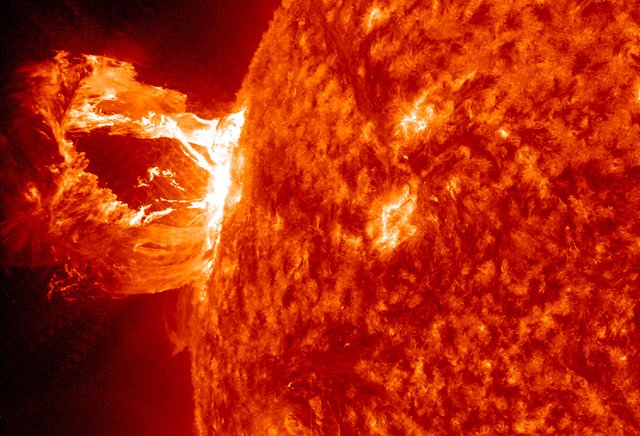The Sun had a massive solar explosion on April 16th.
A coronal mass ejection (CME) is a massive burst of solar wind, other light isotope plasma, and magnetic fields rising above the solar corona or being released into space.
Coronal mass ejections are often associated with other forms of solar activity, most notably solar flares, but a causal relationship has not been established. Most ejections originate from active regions on Sun’s surface, such as groupings of sunspots associated with frequent flares. Near solar maxima the Sun produces about three CMEs every day, whereas near solar minima there is about one CME every five days.
A beautiful prominence eruption shot off the east limb (left side) of the sun on Monday, April 16, 2012. Such eruptions are often associated with solar flares, and in this case an M1 class (medium-sized) flare did occur at the same time, though it was not aimed toward Earth. This event was seen by NASA’s SDO satellite.

“A large CME can contain a billion tons of matter that can be accelerated to several million miles per hour in a spectacular explosion. Solar material streams out through the interplanetary medium, impacting any planet or spacecraft in its path,” explains NASA, who told us that this particular blast reached to the far end of our solar system.
NASA’s Karen Fox said the “height” of the CME (from our perspective) was “25 earth radii high”—198,000 miles.
HD Video of the solar explosion:
[flickr 7084820027 640 480]
Find out more photos from NASA by clicking here
Particles from a recent solar storm will slam today into Earth and produce amazing Northern Lights, or auroras. On the downside, experts expect radio blackouts for a few days, caused by the radiation from the flare – or coronal mass ejection (CME) – causing magnetic storms.
The flare is part of a larger increase in activity in the Sun, which runs in 11-year cycles. It is expected to peak around 2013.
The National Oceanic and Atmospheric Administration’s Space Weather Prediction Center wrote: “Category G1 (Minor) geomagnetic storms are expected 28 and 29 December due to multiple coronal mass ejection arrivals. R1 (Minor) radio blackouts are expected until 31 December.”
A coronal mass ejection (CME) contains billions of tons of gases bursting with X-rays and ultraviolet radiation that are flung into space at around 5 million mph.
They are mind-bogglingly hot – around 100,000,000 C.
The Earth is occasionally hosed by these ejections, leading to amazing shimmering light shows.
They are caused by the ionized solar particles becoming imprisoned by Earth’s magnetic field, exciting the gases in the atmosphere and emitting bursts of energy in the form of light.

A coronal mass ejection (CME) contains billions of tons of gases bursting with X-rays and ultraviolet radiation that are flung into space at around 5 million mph
However, these particles can also cause magnetic storms, which in extreme cases have been known to disrupt satellites and electricity grids.
In 1989, a CME was held responsible for leaving six million people in Quebec, Canada, without power.
Last month one of the largest storms our star can produce was detected.
Known as an X1.9 flare, it was one of the biggest seen in years.
The flare was so powerful that it disrupted communications systems on earth around 45 minutes later.
Another gigantic flare occurred in August, but because it took place on the side of the Sun not facing Earth, there was no disruption to communications or power.
[youtube rrBl5f08rhw]


